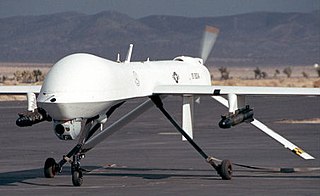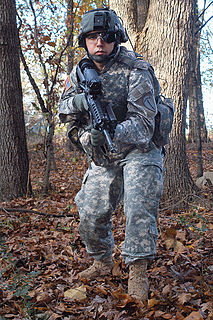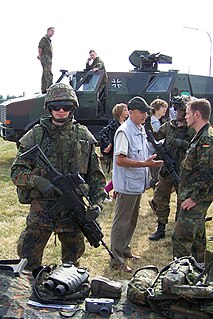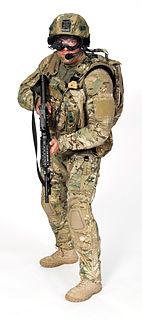
Military robots are autonomous robots or remote-controlled mobile robots designed for military applications, from transport to search & rescue and attack.
The Future Integrated Soldier Technology sometimes incorrectly referred to as the Future Infantry System Technology or Future Infantry Soldier Technology is a project by the British Army, which aims to enhance the infantry's combat effectiveness in the 21st century as part of the Future Soldier project. The contract was awarded to Thales in March 2003.

Land Warrior was a United States Army program, cancelled in 2007 but restarted in 2008, that used a combination of commercial, off-the-shelf technology (COTS) and current-issue military gear and equipment designed to:

The Joint Tactical Radio System (JTRS) aimed to replace existing radios in the American military with a single set of software-defined radios that could have new frequencies and modes (“waveforms”) added via upload, instead of requiring multiple radio types in ground vehicles, and using circuit board swaps in order to upgrade. JTRS has seen cost overruns and full program restructurings, along with cancellation of some parts of the program. JTRS is widely seen as one of the DoD's greatest acquisition failures, having spent $6B over 15 years without delivering a radio.

Infanterist der Zukunft is the German Bundeswehr's program as part of the Future Soldier project. It is a modular, integrated fighting system designed to provide significant lethality, survivability, mobility, battle command, and training to the German infantryman. It is being developed by EADS Defence Electronics and Rheinmetall-Detec.

Future Force Warrior was a United States military advanced technology demonstration project that was part of the Future Combat Systems project. The FFW project sought to create a lightweight, fully integrated infantryman combat system. It was one technology demonstration project in a series of network-centric, next-generation infantry combat projects the U.S. military have developed over the past decade, such as the Soldier Integrated Protective Ensemble technology demonstration program, Land Warrior, and Transformation of the United States Army.
The Lightweight Small Arms Technologies (LSAT) program is funded by the U.S. Joint Service Small Arms Program, with the goal of significantly reducing the weight of small arms and their ammunition. Following a series of military programs to investigate advances in small arms, the LSAT program is the US military's latest project to replace existing US small arms. Tactical concepts and the research from the previous small arms programs indicates that lightening small arms is the first significant step towards increasing soldiers' lethality and survivability.

The Aeronautical Systems Center (ASC) is an inactivated Air Force product center that designed, developed and delivered weapon systems and capabilities for U.S. Air Force, other U.S. military, allied and coalition-partner warfighters. ASC managed 420 Air Force, joint and international aircraft acquisition programs and related projects; executed an annual budget of $19 billion and employed a workforce of more than 11,000 people located at Wright-Patterson Air Force base and 38 other locations worldwide. ASC's portfolio included capabilities in fighter/attack, long-range strike, reconnaissance, mobility, agile combat support, special operations forces, training, unmanned aircraft systems, human systems integration and installation support. ASC was deactivated during a July 20, 2012 ceremony held at Wright-Patterson Air Force Base, Ohio.
F-INSAS is India's program to equip its infantry with state-of-the-art equipment, F-INSAS standing for Future Infantry Soldier As a System. However the Indian Army has decided to drop the F-INSAS program in favour of two separate projects. The new program will have two components: one to arm the future infantry soldier with the best available assault rifle, carbines and personal equipment, such as helmets and bulletproof vests. The second component is the Battlefield Management Systems (BMS).
The Advanced Combat Man System (ACMS) is part of the Singapore Armed Forces's (SAF) move to integrate into 3G to progressively provide tactical units with network capabilities, including C4I capabilities in the field. The project costs about SG$100 million to maintain.
The Integrated Soldier System Project (ISSP) is Canada's program to equip dismounted soldiers with state-of-the-art equipment, using a combination of commercial, off-the-shelf technologies (COTS) and current-issue military gear. The equipment is designed to improve command execution, target acquisition and situational awareness by:

The FB Radom MSBS Grot is a modular assault rifle developed and manufactured by FB "Łucznik" Radom.
Program Executive Office Soldier is a US Army organization that is responsible for rapid prototyping, procurement, and fielding of equipment for its soldiers.

The Enhanced Combat Helmet (ECH) is a combat helmet designed in conjunction of a joint program of the United States Marine Corps and United States Army to replace the current combat helmets in use by the U.S. Army, Air Force, Navy, and Marines. Although similar in shape of the Advanced Combat Helmet and its predecessor the Modular Integrated Communications Helmet, the ECH instead is constructed using thermoplastics instead of the ballistic fibers used on the previous generation combat helmets. The term "Enhanced Combat Helmet" was originally coined by Army Lieutenant Colonel William R. Schaffer.

The Lancaster House Treaties of 2010 are two treaties between the United Kingdom and France for defence and security cooperation. They were signed at 10 Downing Street on 2 November 2010 by British prime minister David Cameron and French President Nicolas Sarkozy.
TALOS was the name given to a powered exoskeleton, first proposed in 2013, that United States Special Operations Command intended to design with the help of universities, laboratories, and the technology industry. The brief for TALOS stated that it had to be bulletproof, weaponized, have the ability to monitor vitals and give the wearer enhanced strength and perception. The suit would comprise layers of smart material and sensors. The suit may have not been intended for an entire squad, but to protect a lead operator who would breach a door first, the most vulnerable team operator in that situation. TALOS was not a program as such; it has been described as an "effort".

Ratnik is a Russian future infantry combat system. Some components, including the communication systems and night vision technologies, have extremely limited military distribution. It is designed to improve the connectivity and combat effectiveness of combat personnel in the Russian Armed Forces. Improvements include modernised body armour, a helmet with a special eye monitor, communication systems, and special headphones. It includes 10 subsystems and 59 individual items.

The United States Army Futures Command (AFC) is a United States Army command, designed as a public-private initiative, that runs modernization projects for the Army. It is headquartered in Austin, Texas, and was first commanded by General John Murray.

The Main Ground Combat System (MGCS) is a project by France and Germany since 2012 to replace their currently deployed Leclerc and Leopard 2 main battle tanks (MBTs). In 2016, the program was in the concept phase which was projected to be completed by 2017.

The Leopard 2PL is a main battle tank used by the Polish Armed Forces, and is a modernized version of the older Leopard 2A4 tank, phased out by Germany and first acquired by Poland in the 2000s. The modernisation is currently being carried out in cooperation with Rheinmetall and the Polish Armaments Group.












